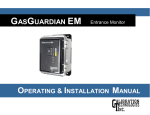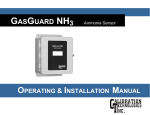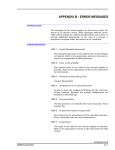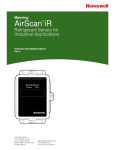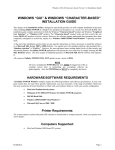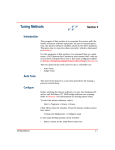Download User Manual - Calibration Technologies
Transcript
GASGUARDIAN 23 2-Channel Controller OPERATING & INSTALLATION MANUAL GasGuardian 23 Operating and Installation Manual Table of Contents General description ………………………………………………...…. 3 Installation………………………………….…………………………… 3 Locating the GasGuardian-2 …………………………. …………. 4 Installation guidelines………………………………………………. 4 Wiring………………………………………………………………… 5 Operation ………………………………………………………………. 6 Start-up ……………………………...……………………………… 6 Keypad ……………………………….….…………………………. 6 LCD Operator Interface…………………………………………… 6 Navigating the Menu……………………………………………….. 7 Normal operating mode………………………………………... 7 Channel view…………………………………………………… 7 Main menu……………………………………………………… 7 Alarm log………………………………………………………… 7 Calibration mode……………………………………………….. 7 Last calibration date…………………………………………… 8 Config menu……………………….…………………………… 8 Clock……………………………………………………………. 9 Contrast………………………………………………………… 9 Relay test………………………………………………………. 9 Maintenance…………………………………………………………… 10 Specifications…………………………………………………………. 10 Warranty……………………………………………………………….. 11 2 3GasGuardian 2 Operating and Instruction Manual Table of Contents General description ………………………………………………...…. 4 Installation………………………………….…………………………… 4 Locating the GasGuardian 2 …………………………. …………. 4 Installation guidelines………………………………………………. 4 Wiring………………………………………………………………… 5 Operation ………………………………………………………………. 7 Start-up ……………………………...……………………………… 7 Keypad ……………………………….….…………………………. 7 LCD Operator Interface…………………………….……………… 7 Menu Tree……………………………………………….………….. 8 Navigating the Menu…………………………………………......... 9 Normal operating mode………………………………………... 9 Channel view……………………………………………….…… 9 Main menu………………………………………………………. 9 Alarm log………………………………………………………… 9 Calibration mode……………………………………………….. 9 Last calibration date……………………………………………10 Config menu……………………….……………………………10 Clock……………………………………………………………. 11 Contrast………………………………………………………… 11 Relay test………………………………………………………. 11 Maintenance…………………………………………………………… 12 Specifications…………………………………………………………. 12 Warranty……………………………………………………………….. 13 Calibration Technologies 866-394-5861 3 GasGuardian 23 Operating and Installation Manual General Description Installation The GasGuardian 2 is a two-channel controller designed to accept two 4/20 mA input signals. It provides a regulated 2.2 Amp, 24 VDC to power all industry standard 4/20 mA gas transmitters. Locating the GasGuardian 2 The GasGuardian 2 provides continuous real-time monitoring of each sensor. The backlit LCD display provides an at-a-glance status of gas concentrations and alarms. Installation Guidelines: The GasGuardian 2 is assembled into a wall mounted enclosure designed for non-classified locations. The gas sensors (one or two) are installed at specific locations where gas is to be detected, up to 1,500 feet from the controller. They are electrically connected to the controller via three conductor cables. The onboard relays have 10 second on/off time delays to prevent unnecessary cycling during a fault, warning or alarm condition. All operator functions are performed from the keypad on the front of the panel. 4 The important consideration when installing GasGuardian-2 controller is that it must be easily accessible for operating personnel. • Mount controller on a solid surface with minimal vibration • Mount controller thru the holes in the mounting flanges • Mount controller in a general-purpose location only. Do not install in a hazardous environment. • Mount controller away from electromagnetic interference. • Protect controller from physical damage. 3GasGuardian 2 Operating and Instruction Manual Wiring Electrical wiring must comply with all applicable codes. Wiring Guidelines: • Always use three-conductor, insulated, stranded, shielded copper cable for all sensor cables. • Do not pull sensor wiring with AC power cables. This can cause electrical interference. • Be sure to land the shield conductors of the sensor cables at the shield terminals of the sensor connectors. • Use only the existing conduit hole for connections to the sensor. • Bonding between metallic conduit connections is not automatic with the non-conductive enclosure. Separate bonding must be provided. Relay Wiring: • AC wiring must be run in separate conduit from the sensor cables. • All relays have Form C dry contacts, and are rated 10 Amps @ 120 VAC or 24 VDC. • Only the fault relay is normally energized. It will de-energize to the alarm state upon sensor fault or loss of power. • Each relay has a status LED to show the state of the relay. During normal operation, all LEDs are off except for the green Fault LED. AC Power Wiring: • Power should be provided by an accessible circuit breaker 5 GasGuardian 23 Operating and Installation Manual Sensor Wiring: 4/20 mA, 350 Ohm input impedance. • Refer to sensor manual for cable recommendations. • Usually 20/3 shielded cable (Belden 8772 or equivalent). • Length of cable should not exceed 1,500 feet. Analog Output Wiring: • The analog output is 4/20 mA signal for monitoring by plant PLC or other analog input equipment. It is powered by the GasGuardian 2. • Use 2-conductor shielded cable compatible with receiving equipment. 6 3GasGuardian 2 Operating and Instruction Manual Operation Start-up Before applying power, make a final check of all wiring for continuity, shorts, grounds, etc. It is usually best to disconnect external alarms and other equipment from the controller until the initial start-up procedures are completed. After initial power-up, allow at least 12 hours for the sensors to stabilize before calibrating. Because sensors are normally located at a distance from the controller, the test time required and accuracy of the response checks will be improved if two people perform the start-up procedures and use radio contact. The GasGuardian 2 has a two-minute power-up delay during which the relays are held in their normal non-alarm state, after the application of power or a momentary power loss. This allows the sensors time to stabilize and disables the alarm functions. Start-Up Test: 1) One person exposes each sensor to target gas. 2) The second person stays at the control unit to determine that each sensor, when exposed to the gas, is connected to the proper input and responds, causing appropriate alarm functions. Keypad All operator functions are performed from the membrane switches on the front of the panel. LCD Operator Interface Key Functions: Below is a list of the common key functions used for the LCD operations: MENU ESC ENTER PREV NEXT YES/NO Alphanumeric Up/Down to enter main menu to go back to previous menu/sub-menu to modify the programming fields to go back to previous screen to advance to next screen when prompted and to accept configuration changes for menu selections and to enter values and text to navigate drop-down lists during configuration Ch1 0 PPM NH3 POWERUP Ch2 0.0 % NH3 Silence Key: Pressing the Silence key will reset the horn relay and silence the buzzer, until the next event occurs. The horn relay is triggered by a fault or alarm condition, and can be programmed to trigger during a warning condition. Reset: Pressing the Reset key will attempt to reset any latched relays. Any latched relays will not reset as long as there’s an existing warning or alarm condition. The latch-relay function can be enabled for each relay in the Configuration menu. 7 GasGuardian 23 Operating and Installation Manual Menu Tree Alarm Log 12/29/08 16:39:20 Ch1 ALARM Rly Set 150 ENGINE ROOM PPM 326 Ch1 249 CAL Mode Alarm PPM Warn NH3 ENGINE ROOM Alarm Log 12/29/08 16:39:33 HORN Silence Ch1 327 ENGINE ROOM Ch1 162 CONFIG Menu Ch2 0.0 % NH3 Fault Ch1 CONFIG Menu CONFIG Mode Ch2 1) CONFIG Ch 1 2) CONFIG Ch 2 PPM Warn % NH3 NH3 Fault 249 Alarm 0.0 Password: 5861 VENT LINE 162 Alarm 0.0 CAL Mode Ch2 PPM Warn NH3 Alarm PPM Warn NH3 CONFIG Mode % NH3 Ch 1: State 11/20/08 14:50:54 Ch 1: State Menu 2 of 2 5) Clock 6) Contrast 7) RELAY Test Menu CLOCK CONFIG Mode Channel1: ACTIVE Menu 1 of 2 1) Alarm Log 2) Cal. Mode 3) Last CAL Date 4) CONFIG Menu Last CAL Date Date: 12/29/08 Time: 15:28:46 CONFIG Mode RELAY Test 1) Horn 2) Fault 3) Ch 1 Warn 4) Ch 1 Alarm 5) Ch 2 Warn 6) Ch 2 Alarm RELAY Test #1 - Horn Relay Push <YES> to set relay <NO> to Exit RELAY Test #1 - Horn Relay RELAY SET Push <NO> to clear and Exit CONFIG Mode Latch: YES Ch 1: Alarm CONFIG Mode Set Point: 150 Direction: UPSCALE Ch 1: State Ch 1: Warn Ch 1: State Minimum 0-100 Maximum 35 Ch 1: Alarm Channel1: ACTIVE CONFIG Mode Channel1: NOT ACTIVE Contrast 8 Ch 1: Location ENGINE ROOM CONFIG Mode CONFIG Mode Latch: NO Horn: NO Ch 1: Warn CONFIG Mode Channel1: NOT ACTIVE Set Point: 50 Direction: UPSCALE Ch 1: Range Ch 1: Unit/Gas CONFIG Mode CONFIG Mode Span: 250 Zero: 0 Unit: PPM Gas: NH3 3GasGuardian 2 Operating and Instruction Manual Navigating the Menu Normal operating mode After system power-up, the normal operating screen will be displayed. It provides at-aglance system status, showing real-time gas concentrations. In this example, channel 1 gas concentration has exceeded the warn and alarm setpoints. Channel 2 indicates a fault due to faulty wiring or a sensor signal less than 1 mA. The Warn, Alarm and Fault indications will flash until the conditions are cleared. PREV or NEXT to go to Channel View screens MENU to go to main menu screen Channel view Channel view displays only the status of the channel being viewed. It also displays the room/zone location. Warn, Alarm and Fault indications will flash until the conditions are cleared. PREV or NEXT to view normal operating screen or next channel view screen. MENU to go to main menu screen. An over-range condition is indicated by flashing of the full-scale reading. This also indicates that the sensor output is over 20 mA. Main Menu The main menu can be accessed by pressing the menu key at any time. Use the alphanumeric keys to select a sub-menu, or NEXT to advance to the next menu screen. ESC to return to the normal operating screen. Ch1 Main Menu (cont.) Menu 2 of 2 5) Clock 6) Contrast 7) RELAY Test Menu Alarm Log The alarm log captures every event in chronological order, with the most recent event displayed first. 10,000 events can be stored, with the oldest events being automatically truncated, once the alarm log is full. Time/date stamp and event number are also displayed. PREV or NEXT to scroll. Hold button in for turbo-scroll. ESC to return to normal operating screen. MENU to return to main menu screen. Alarm Log 12/29/08 16:39:33 HORN Silence Ch2 162 Alarm 0.0 PPM Warn % NH3 NH3 Fault Ch1 162 Alarm PPM Warn NH3 ENGINE ROOM Ch2 0.0 % NH3 Fault VENT LINE Menu 1 of 2 1) Alarm Log 2) Cal. Mode 3) Last CAL Date 4) CONFIG Menu Cal Mode Calibration mode allows for sensor calibration and maintenance by holding the relays in their normal state, preventing unwanted alarms. If the unit is left in Cal Mode, it will stay active for 48 hours and then return to normal operating mode. Make sure the concentration values have dropped below the warning and alarm setpoints before exiting. ESC to exit from Calibration mode and return to normal operating mode. The analog outputs are not affected by calibration mode and are allowed to increase to full scale. 327 Alarm Log 12/29/08 16:39:20 Ch1 ALARM Rly Set 150 ENGINE ROOM PPM 326 CAL Mode Ch1 Ch2 249 Alarm 0.0 PPM Warn % NH3 NH3 Ch1 249 CAL Mode Alarm PPM Warn NH3 ENGINE ROOM 9 GasGuardian 23 Operating and Installation Manual Last CAL Date The last cal date shows the date and time at which the system was last calibrated. When six months has transpired from the last cal date, a Cal Due flag will appear indicating the sensors need to be calibrated., Holding the 6 key, and then pressing the 7 key will reset the Cal Date, once the sensors are calibrated. Last CAL Date CONFIG Menu The Configuration menu is password protected to prevent unauthorized personnel from making programming changes to the system. Enter the password (last 4 digits of CTI toll-free phone number) with the alphanumeric keys. CONFIG Menu Enter number 1 or 2 to configure that channel (repeat same steps for both channels). State: Allows for turning on or off a channel. For example, if a sensor is removed from the system, that channel should be changed to NOT ACTIVE. To change this programming field, press ENTER to highlight the field. Use up or down arrows to select item. 11/20/08 14:50:54 CONFIG Mode Channel1: NOT ACTIVE Press ENTER to select item. Ch 1: State CONFIG Mode Channel1: NOT ACTIVE Password: 5861 CONFIG Menu CONFIG Mode 1) CONFIG Ch 1 2) CONFIG Ch 2 Ch 1: State CONFIG Mode Range: Allows adjustment of sensor zero and full scale range. (use alphanumeric keys to enter values) Ch 1: Range Unit/Gas: Use these fields to change the unit of measurement and gas type. Ch 1: Unit/Gas CONFIG Mode Warning Setpoint: Use this field to change the default warning setpoint Direction: Use this field to change the default direction setting. For example, oxygen level monitoring may require downscale alarming. Ch 1: Warn Channel1: ACTIVE Ch 1: State CONFIG Mode Channel1: ACTIVE 10 Ch 1: State CONFIG Mode Span: 250 Zero: 0 Unit: PPM Gas: NH3 CONFIG Mode Set Point: 50 Direction: UPSCALE 3GasGuardian 2 Operating and Instruction Manual Latch for Warn Relay: Allows warning relay of channel being programmed to latch. A latched relay must be cleared by pressing the RESET button, once the gas has cleared. Horn: Allows horn relay and buzzer to activate during a Warn condition. Alarm Setpoint: Use this field to change the default alarm setpoint. Direction: Use this field to change the default direction setting. For example, oxygen level monitoring may require downscale alarming. Latch for Alarm Relay: Allows alarm relay of channel being programmed to latch once activated. A latched relay must be cleared by pressing the RESET button, once the gas has cleared. Location Name: Use this field to name the location of the sensor being programmed. To delete the existing label, ENTER and then PREV to delete characters. Ch 1: Warn CONFIG Mode Latch: NO Horn: NO Ch 1: Alarm Relay Test The relay test menu allows the relay outputs to be tested individually for correct output functions. Select the relay to be tested with the alphanumeric keys. Press YES to Set relay. NO to exit. RELAY Test 1) Horn 2) Fault 3) Ch 1 Warn 4) Ch 1 Alarm 5) Ch 2 Warn 6) Ch 2 Alarm CONFIG Mode ENGINE ROOM RELAY Test #1 - Horn Relay Push <YES> to set relay <NO> to Exit Relay has been set. Press NO to clear the relay and exit once the relay output function has been verified. ESC to return to Config menu. Clock Set current time and date. Minimum 0-100 Maximum 35 CONFIG Mode Latch: YES Ch 1: Location Contrast CONFIG Mode Set Point: 150 Direction: UPSCALE Ch 1: Alarm Contrast Adjust contrast to allow for best viewing of LCD. RELAY Test #1 - Horn Relay RELAY SET Push <NO> to clear and Exit CLOCK Date: 12/29/08 Time: 15:28:46 ESC back to Config main menu. Press YES to save changes. Press ESC again to exit without saving changes. 11 GasGuardian 23 Operating and Installation Manual Maintenance All gas detection systems should be calibrated with certified calibration gas once every six months. At this interval, all alarm functions and outputs should be tested, verified and documented. If sensor span or zero cannot be adjusted, the sensor may be approaching its end of life and must be replaced. Keep an operation log of all maintenance, calibrations and alarm events. To clean the controller, use a mild cleaning solution and soft cloth. 12 Specifications AC Power Requirements: 120 VAC @ 1 A DC Power Available For Sensors and connected audio/visual devices: +24 VDC @ 2.2 A Dimensions: 11.3” high x 9.3” wide x 7” deep Weight: 6 lbs Enclosure: Fiberglass Reinforced Polyester NEMA 4X, with polyurethane gasket. Continuous stainless steel hinge. Captive screws in lid. For nonclassified areas. Temperature Range: 0°F to +122°F Humidity Range: 0% to 100% condensing, with proper conduit seals Sensor Inputs: 4/20 mA, 350 Ohm input impedance Analog Outputs: (2) Linear 4/20 mA (max input impedance: 700 Ohms) Relay Outputs: (6) SPDT relays, 10A @ 24 VDC or 120 VAC User Interface: LCD illuminated screen. Graphic display screen: 128 x 64 pixels. 8 lines x 22 characters. 16 sealed membrane switches. Limited Warranty & Limitation of Liability Calibration Technologies, Inc. (CTI) warrants this product to be free from defects in material and workmanship under normal use and service for a period of 2 years, beginning on the date of shipment to the buyer. This warranty extends only to the sale of new and unused products to the original buyer. CTI’s warranty obligation is limited, at CTI’s option, to refund of the purchase price, repair, or replacement of a defective product that is returned to a CTI authorized service center within the warranty period. In no event shall CTI’s liability hereunder exceed the purchase price actually paid by the buyer for the Product. This warranty does not include: a) routine replacement of parts due to the normal wear and tear of the product arising from use; b) any product which in CTI’s opinion, has been misused, altered, neglected or damaged by accident or abnormal conditions of operation, handling or use; c) any damage or defects attributable to repair of the product by any person other than an authorized dealer or contractor, or the installation of unapproved parts on the product The obligations set forth in this warranty are conditional on: a) proper storage, installation, calibration, use, maintenance and compliance with the product manual instructions and any other applicable recommendations of CTI; b) the buyer promptly notifying CTI of any defect and, if required, promptly making the product available for correction. No goods shall be returned to CTI until receipt by the buyer of shipping instructions from CTI; and c) the right of CTI to require that the buyer provide proof of purchase such as the original invoice, bill of sale or packing slip to establish that the product is within the warranty period. THE BUYER AGREES THAT THIS WARRANTY IS THE BUYER’S SOLE AND EXCLUSIVE REMEDY AND IS IN LIEU OF ALL OTHER WARRANTIES, EXPRESS OR IMPLIED, INCLUDING BUT NOT LIMITED TO ANY IMPLIED WARRANTY OF MERCHANTABILITY OR FITNESS FOR A PARTICULAR PURPOSE. CTI SHALL NOT BE LIABLE FOR ANY SPECIAL, INDIRECT, INCIDENTAL OR CONSEQUENTIAL DAMAGES OR LOSSES, INCLUDING LOSS OF DATA, WHETHER ARISING FROM BREACH OF WARRANTY OR BASED ON CONTRACT, TORT OR RELIANCE OR ANY OTHER THEORY. 13 GG-2 09/2014 v1.13
















